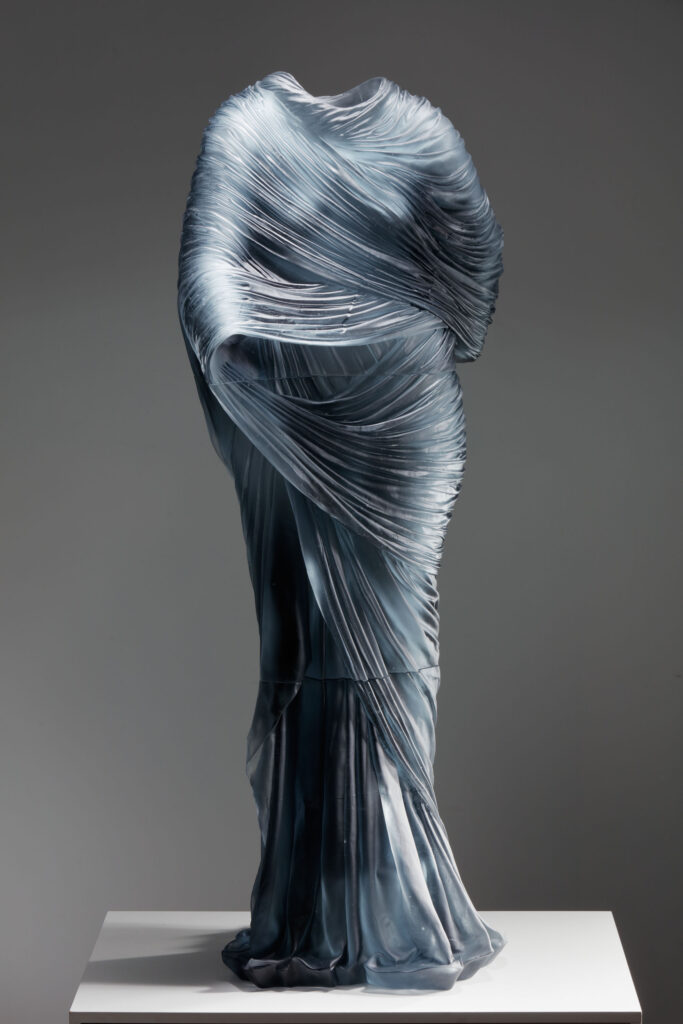
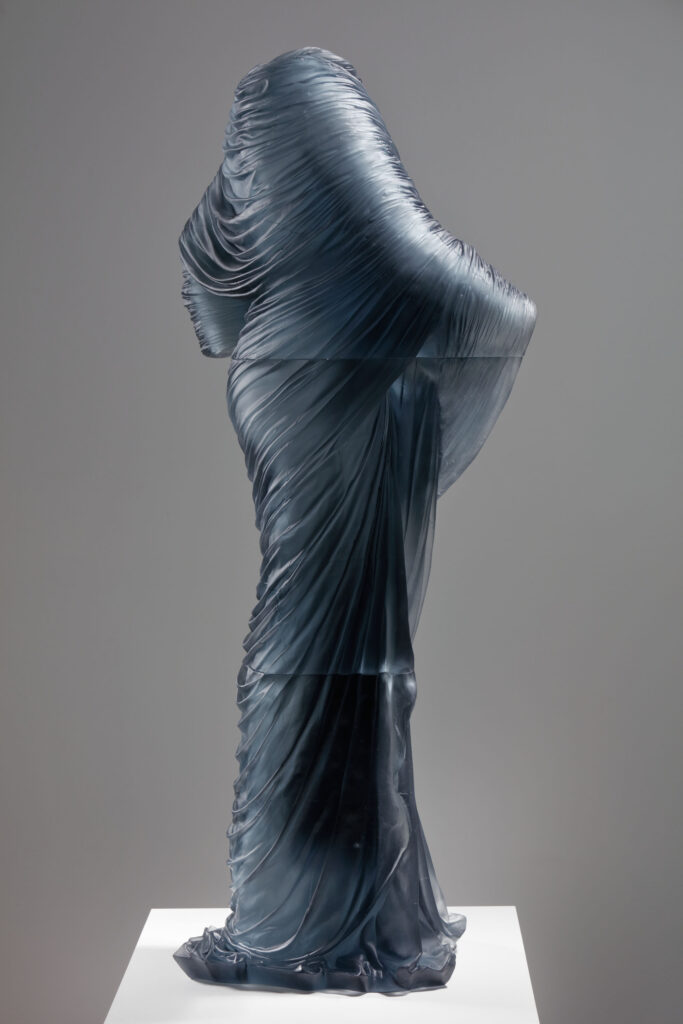
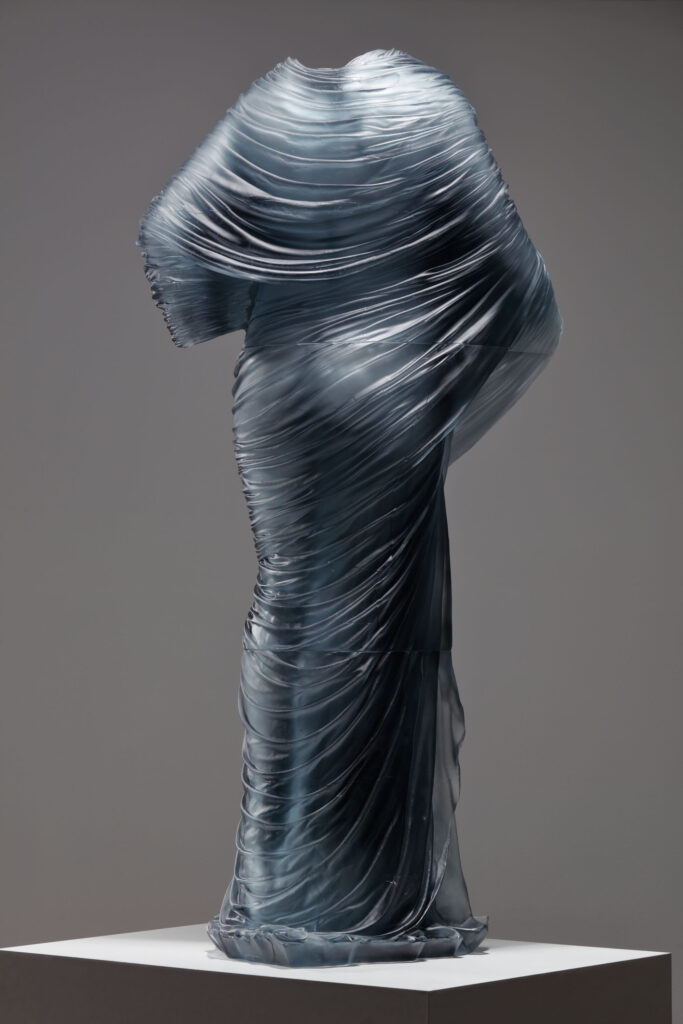
About the Art
On the ground floor of the west entry of Morrill Hall on Iowa State University’s campus, a large-scale cast glass stands. Constructed in the Czech Republic and installed in 2017, the sculpture, Nocturne 5, was created using the lost wax process followed by grit blasting and acid polishing. The result is a life-sized, standing female figure wrapped in drapery, where you can see the impression of a body, once there but now gone, in the empty dress.
The artist, Karen LaMonte, is internationally recognized as her cast glass figures, including Nocturne 5, explore the human form as an artistic medium. The drapery is meticulously arranged extending from the top right shoulder down across the left arm, from the left waist over the outstretched right arm, down across the left hip, and below the hip, the drapery falls vertically into a pile at the feet.
Nocturne 5 is part of her Nocturnes series that exemplifies the translucent beauty of sculptural glass. The glass at the top of the sculpture is lighter and more transparent than the base which is darker and opaquer. The darker hues represent the change from day to night (the gradation of the gray blue hue) such as twilight when the sky brings upon a sense of mystery, depth, and a limitless sense of space.
LaMonte also found inspiration in the paintings of James Abbott McNeill Whistler and the music of John Field and Frederic Chopin which can be seen in her night-themed series Nocturnes. The compositions consist of dress sculptures, where she designed and sewed evening dresses to wrap the female body in night with some figures standing and others modeled in reclining positions, a reference to the traditional odalisque through the removal of the nude body itself.
LaMonte describes her Nocturnes series as “A new body of work inspired by the beauty of night. I call these sculptures Nocturnes: dark, seductive, and sublime. They are absent female forms rising from penumbral garments as figurations of dusk. They build on the tradition of the female nude and probe the tension between humanism and eroticism, the physical and the ethereal, the body and the spirit. The figures are at once intensely physical – muscles and flesh strain against clinging fabric – and yet insubstantial: the figures are absent, implied only by the shapes pressing against the clothing.”
Nocturne 5 continues to emphasize the figural sculptural tradition found on Iowa State University’s campus that began with artist-in-residence Christian Petersen, while also adding LaMonte as a significant contemporary glassmaker to the university’s collection. The sculpture stands in the same building outside the entrance to the Christian Petersen Art Museum in Morrill Hall.
YouTube Video: Nocturnes | Figurative Sculptures of Night by Karen LaMonte
About the Artist
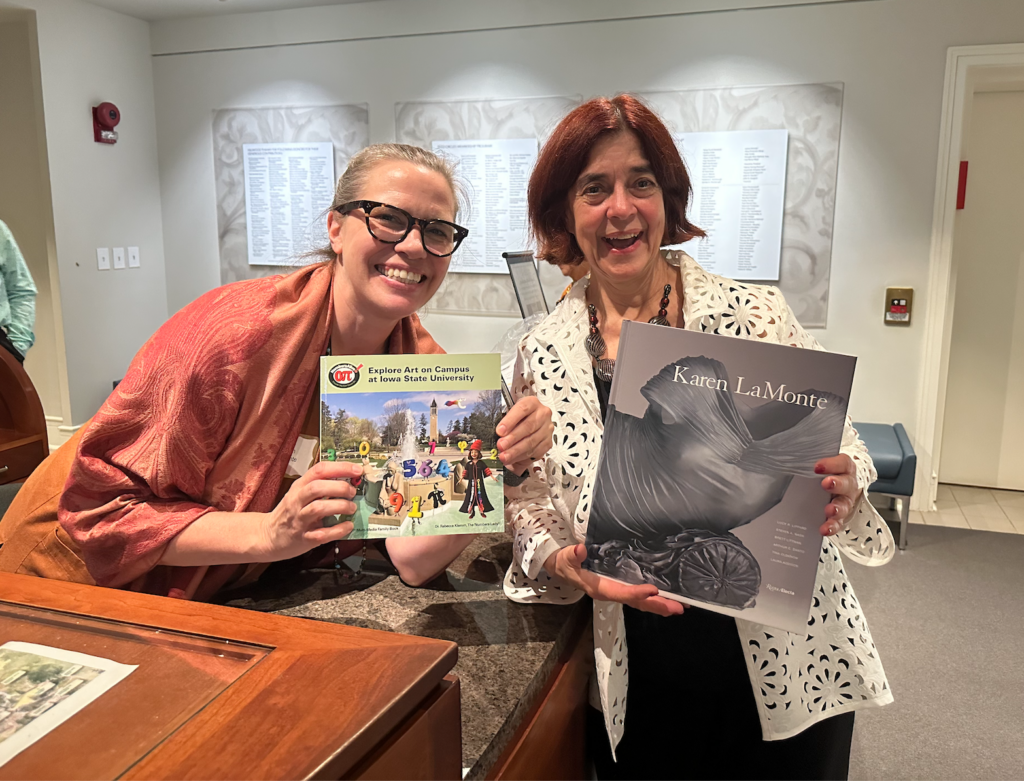
Karen LaMonte and Dr. Klemm with their books at Hillwood Museum and Gardens, September 12, 2023!
Born in 1967 in Manhattan, New York, Karen LaMonte’s career consists of creating sublime and enigmatic works in glass, ceramic, bronze, iron, paper, and marble ranging from monotype prints to monumental stone sculptures that explore themes of beauty, gender, identity, and the natural world.
In 1990, after she graduated from the Rhode Island School of Design with a bachelor’s in fine arts with honors, LaMonte was awarded a fellowship at the Creative Glass Center of America, in Millville, New Jersey. Subsequently she moved to Brooklyn, New York and worked at UrbanGlass, a not-for-profit public access glass studio. While at UrbanGlass, LaMonte’s glass sculptures were exhibited at fine art galleries.
In 1999 LaMonte received a Fulbright scholarship to study at the Academy of Arts, Architecture and Design in Prague. In 2000, while in Prague, she created her first major work, Vestige, a glass sculpture depicting a life-sized dress absent the wearer. She soon gained critical acclaim receiving The Louis Comfort Tiffany Foundation Biennial Award in 2001 and the UrbanGlass Award for New Talent in Glass in 2002.
LaMonte subsequently established a permanent studio in Prague where she created her first series, Absence Adorned. The life-sized glass sculptures examine the interplay between public and private identities through garments that are opulently draped on invisible female figures, reinventing the traditional portrayal of the nude. The sculptures from Absence Adorned were first shown in a solo exhibition at the Czech Museum of Fine Arts in Prague and have been widely exhibited since.
In 2006 LaMonte was awarded a seven-month fellowship to study in Kyoto, Japan by the Japan-United States Friendship Commission. She explored clothing, culture, and identity such as the significance of the traditional Japanese kimono. Back in Prague, LaMonte used biometric data of Japanese women to create dress sculptures in ceramic, cast glass, rusted iron, and bronze. This trip inspired her Floating World series of works that have been featured in exhibitions and permanent collections at the Hunter Museum of American Art in Chattanooga, Tennessee and the Museum of Fine Arts, Boston, Massachusetts.
YouTube Video: Floating World | The Mesmerizing Kimono Sculptures by Karen LaMonte
In 2017 and 2019, LaMonte displayed her Nocturnes at Glasstress, an exhibition mounted concurrently with the Venice Biennale and in exhibitions including Embodied Beauty at the Hunter Museum of American Art.
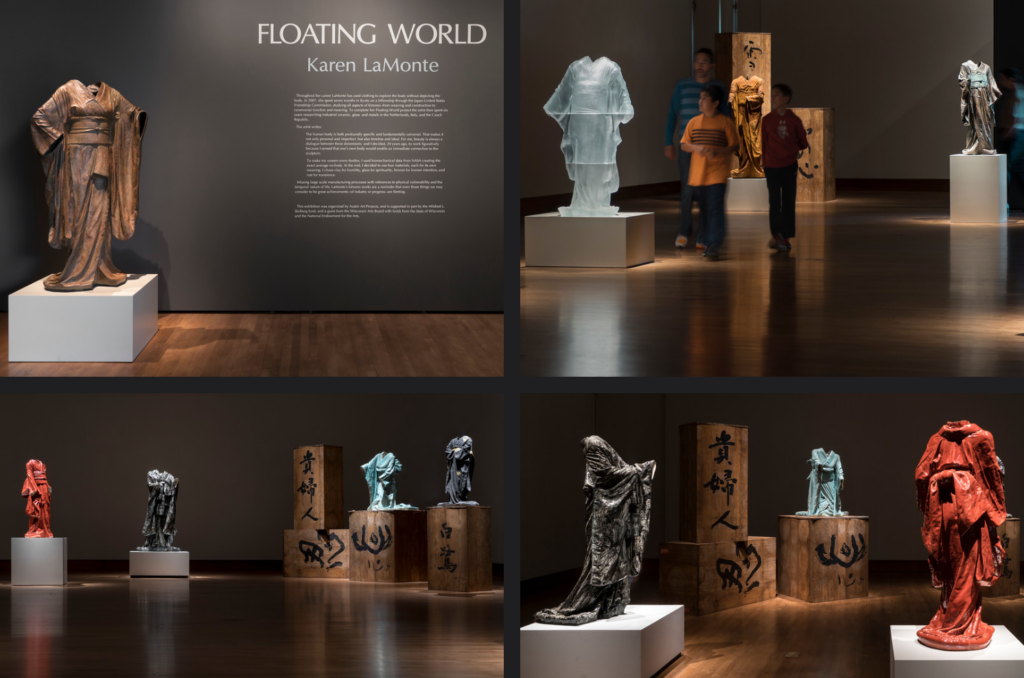
Floating World, Kimono sculptures and maquettes with ukiyo-e prints, life-size sculptures of kimonos in bronze, ceramic, rusted iron and glass, August 11 — September 24, 2017, Chazen Museum of Art, University of Wisconsin, Madison, Wisconsin.
*Fun fact: You might recognize this name. There is another sculpture of the same in this book. Visit Floating World here.
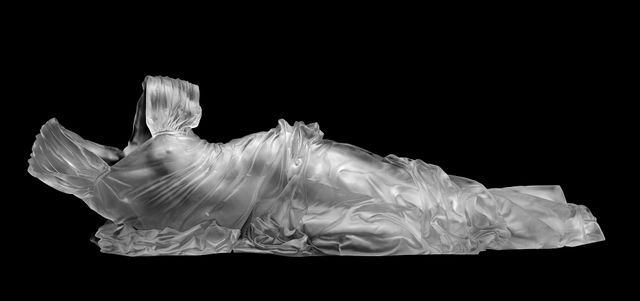
Reclining Dress Impression with Drapery, 2009, Smithsonian American Art Museum, Washington, DC.
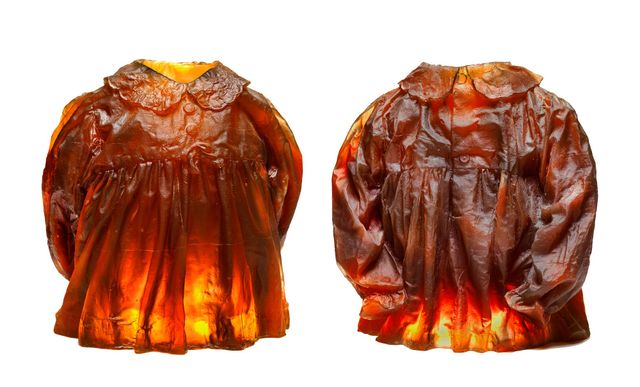
Untitled, 2002, Smithsonian American Art Museum, Washington, DC, gift of Dr. Rebecca Klemm.
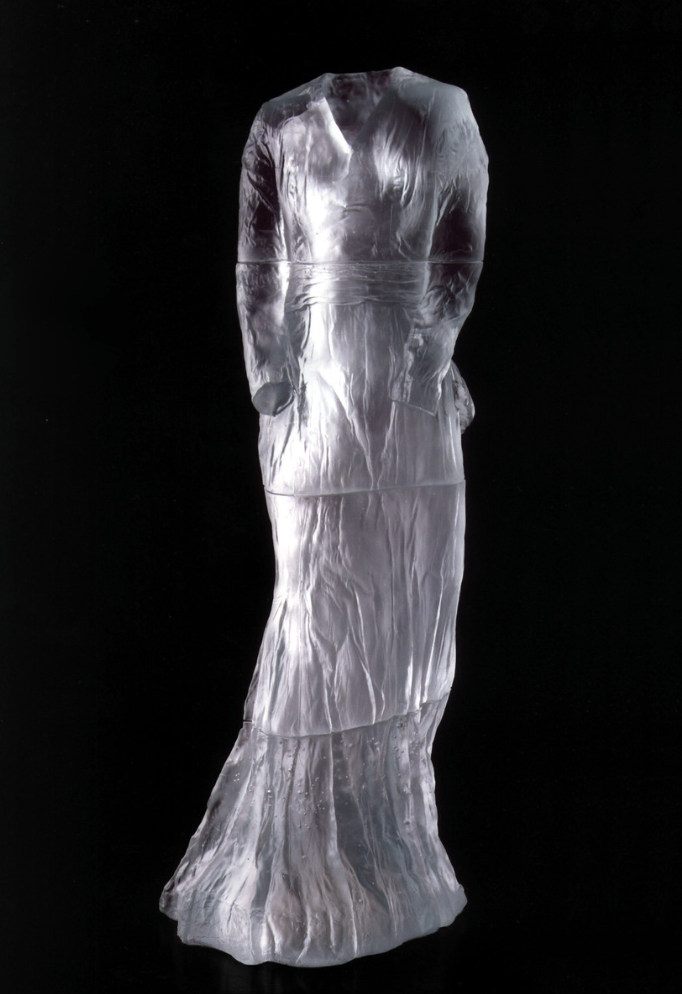
Vestige, 2000
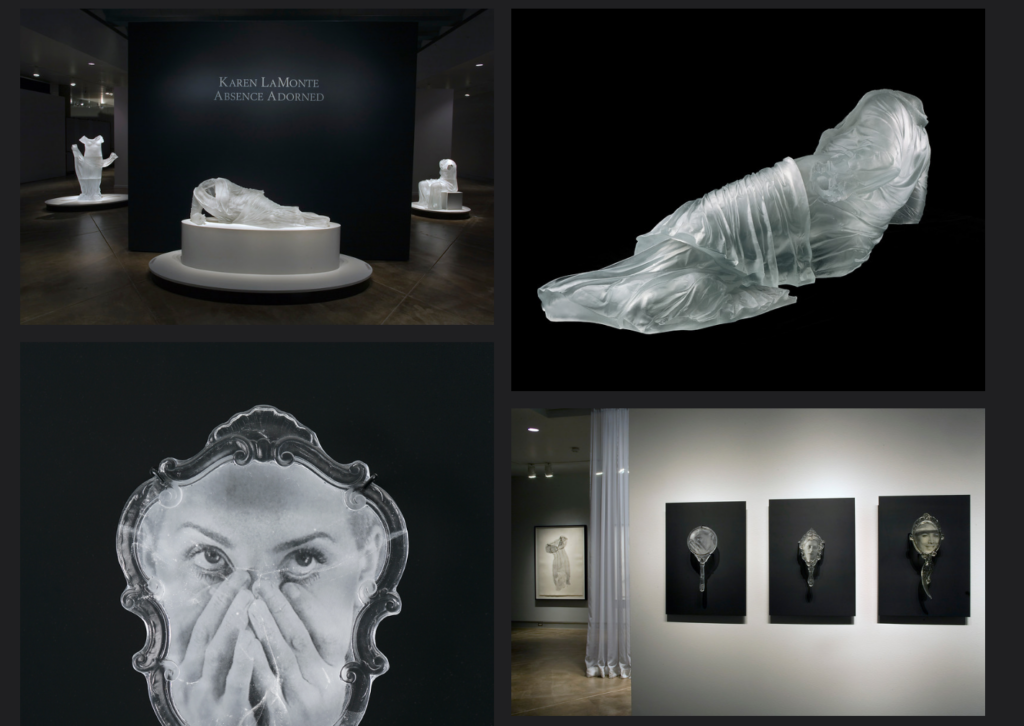
Absence Adorned, solo exhibition of glass dress and mirror artworks, December 10, 2005 – September 4, 2006, Museum of Glass, Tacoma, Washington.
Relevant Terminology/History
Penumbral relates to or being a shadowy, indefinite, or marginal area of an opaque body as in an eclipse.
An affiliated word – tetrad — relates to the situation of four consecutive total lunar eclipses in a row without any penumbral eclipses in between.
Lost wax kiln-casting is a versatile method for making glass pieces in almost any form imaginable. The process involves creating a refractory mold around a wax model. The wax is then removed—or “lost”—creating a cavity. Glass is cast into the cavity, resulting in a fully sculptural finished piece.
The Art Biennale (La Biennale d’Arte di Venezia) is one of the world’s largest and most
important contemporary visual art exhibitions. So-called because it is held biannually, it is the
original biennale on which others in the world have been modeled. The exhibition space spans over 7,000 square meters, and artists from over 75 countries are represented in the collective exhibition spaces as well as in the national pavilions.
Until 2019, the Art Biennale used to take place in odd years and the Architecture Biennale in even years, but after the COVID-19 pandemic forced a postponement, the Art Biennale now takes place in even years (2022, 2024) and the Architecture Biennale in odd years (2021, 2023).
An Odalisque was the term used for a chambermaid or a female attendant in a Turkish seraglio (women’s apartments), particularly in the household of the Ottoman sultan. The term came to mean the harem concubine in western usage. Odalisque also refers to the eroticized artistic genre in which a woman is represented mostly or completely nude in a reclining position, often in the setting of a harem. Below is an example of Ingres’ famous painting, Grande Odalisque.
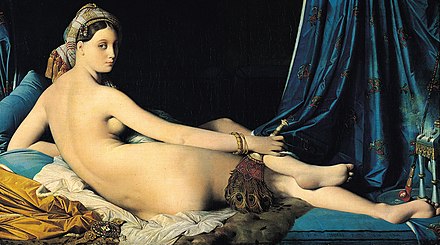
Grande Odalisque, 1814, Jean Auguste Dominique Ingres, Louvre, Paris, France
James Abbott McNeill Whistler (b. 1834, Lowell, Massachusetts —d. 1903, London, England) was an American-born artist noted for his paintings of nocturnal London, his striking and stylistically advanced full-length portraits, and for his etchings and lithographs. See below for examples of Whistler’s paintings.

Whistler’s Mother, 1871, Musée d’Orsay, Paris, France
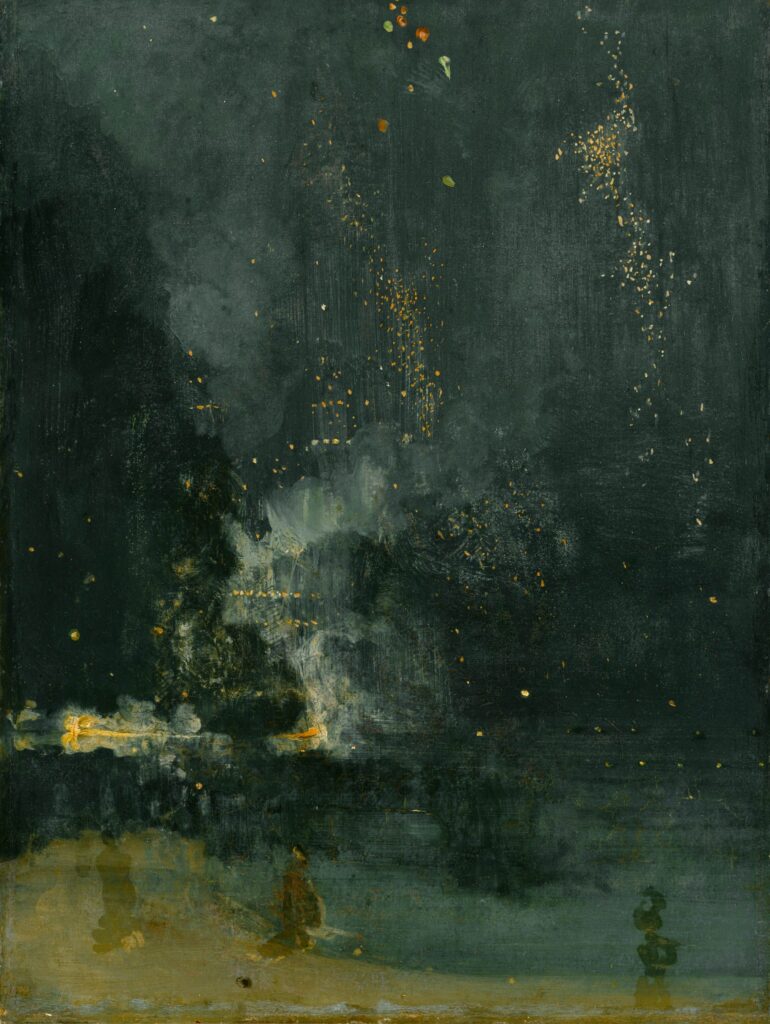
Nocturne in Black and Gold – The Falling Rocket, 1874, Detroit Institute of the Arts, Detroit, Michigan
A Nocturne is a musical composition that is inspired by or evocative of the night.
John Field (b. 1782, Dublin – d. 1837, Moscow) was an Irish pianist, composer, and teacher. Field is widely credited as the inventor of the nocturne. He was the first composer to use the term ‘Nocturne’ to apply to a piece featuring a cantabile (smooth singing style) melody over an arpeggiated (series of ascending or descending notes) accompaniment.
Listen to John Field’s 18 Nocturnes.
Frederic Chopin (1810-1849) was a Polish composer and virtuoso pianist of the Romantic period, who wrote primarily for solo piano. Chopin took the new salon genre of the nocturne, invented by the Irish composer John Field, to a deeper level of sophistication. He was the first to write ballades and scherzi as individual concert pieces. He established a new genre with his own set of free-standing preludes.
Listen to Chopin’s Nocturne Op. 9, No.2.
Athena is an ancient goddess of wisdom, warfare, and handicraft. Athena was regarded as the patron and protectress of cities across Greece, particularly Athens, which received her name. The Parthenon on the Acropolis of Athens is dedicated to her. Her major symbols include owls, olive trees, snakes, and the Gorgoneion. In art, she is generally depicted wearing a helmet and holding a spear.
The Panathenaea was a multi-day ancient Greek festival held annually in Athens that would always conclude on 28 Hekatombaion, the first month of the Attic calendar (ancient calendar of the ancestral area of Athens). The purpose of the festival was to celebrate the goddess, Athena. Every four years the festival was celebrated in a larger manner over a longer time with increased festivities; it was known as the Great (or Greater) Panathenaea. The festival consisted of various competitions and ceremonies, culminating with a religious procession that ended in the Acropolis of Athens.
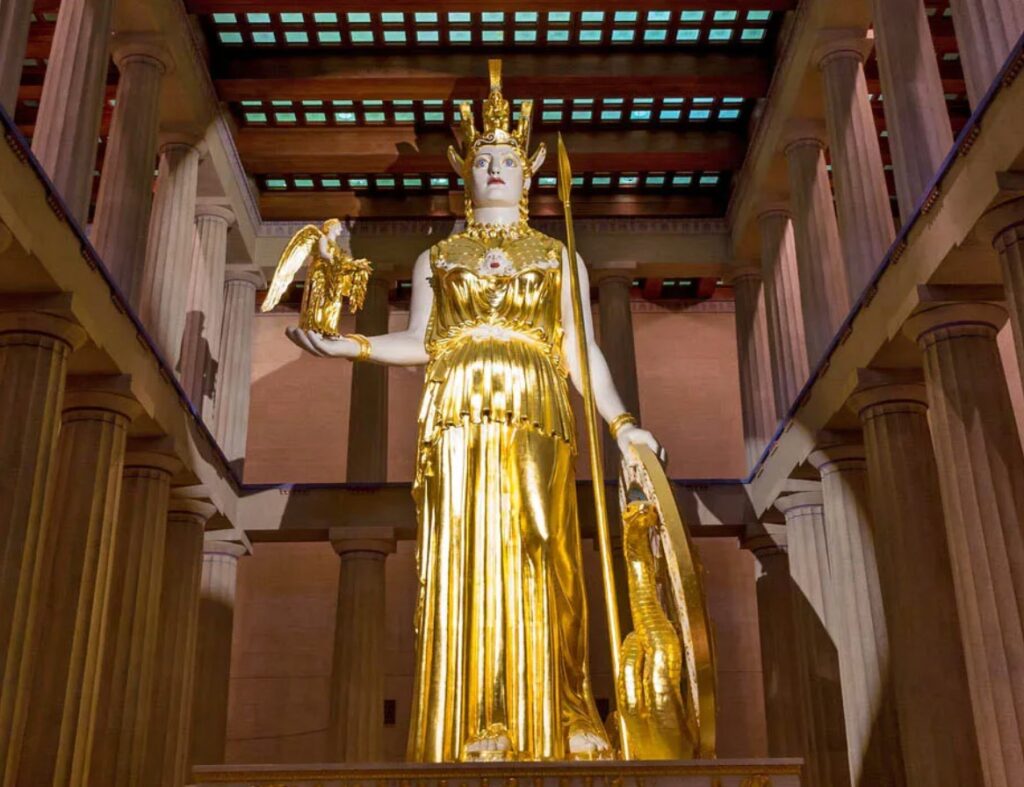
Athena Parthenos was housed in the cella of the Parthenon, Athens, Greece
For diagrams and more information on the Parthenon, visit the page on The Fifth Muse.
9 (nine) is the largest single-digit number in the base-ten system.
Below are some of the idioms you may have heard that reference 9:
- “The whole nine yards”
- “Dressed to the nines”
- “A cat has nine lives”
- “On cloud nine”
- “A stitch in time saves nine”
*Fun Fact: Evita sings the titular song “Don’t Cry for Me Argentina” as part of the movie and musical, “Evita.” She sings “Although she’s dressed up to the nines, At sixes and sevens with you.” Watch the video of Madonna singing the song along with all the lyrics.
At sixes and sevens is an English idiom used to describe a condition of confusion or disarray. The most likely origin of the phrase is the dice game “hazard” a more complicated version of the modern game of “craps.
9 in cultures and history throughout the world
- Indian mythology – In the Vaisheshika branch of Hindu philosophy, there are nine universal substances or elements: Earth; Water; Air; Fire; Ether; Time; Space; Soul; and Mind.
- East Asian mythology – The 9-tailed fox is a common motif in East Asian mythology and is the most famous fox spirit in Chinese culture. In Chinese and East Asian folklore, foxes are depicted as spirits possessed of magic powers. These foxes are often depicted as mischievous, usually tricking other people, with the ability to disguise themselves as a beautiful woman.
- Greek mythology – The nine Muses in Greek mythology are Calliope (epic poetry), Clio (history), Erato (erotic poetry), Euterpe (lyric poetry), Melpomene (tragedy), Polyhymnia (song), Terpsichore (dance), Thalia (comedy), and Urania (astronomy). See The Fifth Muse for more information.
- Norse mythology – the universe is divided into nine worlds which are all connected by the world tree Yggdrasil.
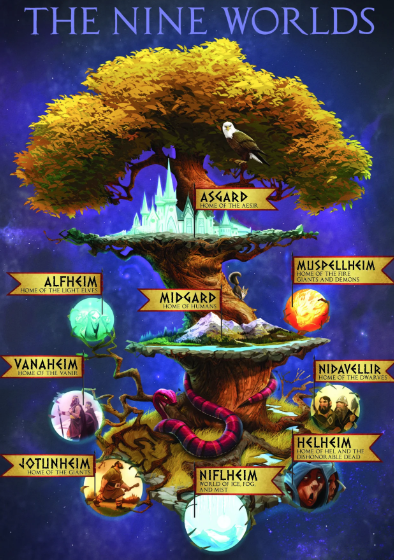
Image of the 9 worlds, courtesy of Viking-Store.
Learning Guide
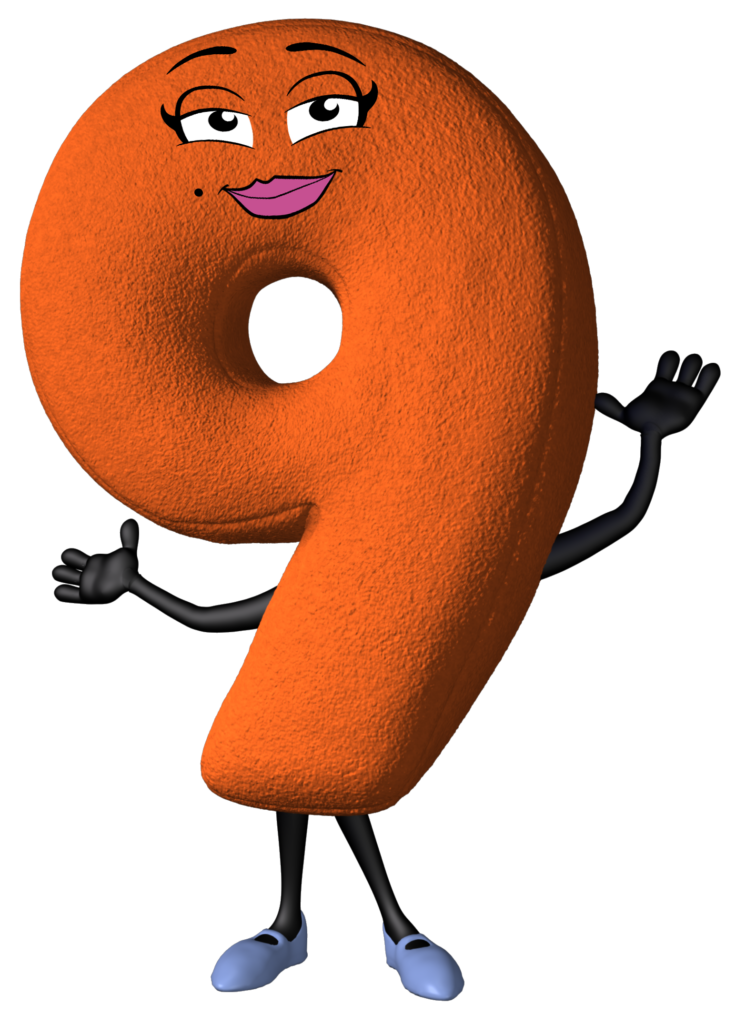
- What do you think the title has to do with the art?
- Why do you think Dr. Klemm selected Number Character 9 to speak about Nocturne 5?
- Can you help Number Character 9 find her cat?
- How does the shape of the red image with white numbers relate to the art? Can you find the shape in the Nocturne 5 layout in the book?
- How does the hidden blue image relate to the Nocturne 5 layout in the book?
- How does the concept of a draped woman’s body presented in Nocturne 5 resemble that of a Greek muse (visit The Fifth Muse in this book) or Athena Parthenos (image above)? Discuss your thoughts with your friends and family.
- If 9 had mentioned feeling like one of the 9 Muses, which do you think she would select that relates most to the concept presented in Nocturne 5? (Visit The Fifth Muse.) Discuss your thoughts with your friends and family.
- Do you think the idiom, “dressed to the 9s” suggests wearing grubby clothes or fancy clothes?
- Are you a Swiftie? What song references the lyrics “The whole place was dressed to the nines”?
- Have you ever felt you were “on cloud nine”? What made the situation special? What could you do to have that happen again?
- To go “the whole nine yards” in school or work team project, would you need to have your tasks completed by the due date, or completed a bit after the time promised? Do you think Karen LaMonte went “the whole nine yards” when designing her first major glass dress, Vestige (see above image)? Discuss your thoughts with your friends and family.
- What do you think Evita means when singing to the crowd in Argentina: “Although she’s dressed up to the nines, At sixes and sevens with you?” Discuss with your friends and family.
- Do you know a game that includes a nine-tailed fox?
- How is a cat related to a fox?
- Can you match the nine worlds of Norse mythology with the nine Greek muses?
- Do you think all of the nine universal substances or elements of the Vaisheshika branch of Hindu philosophy are located on the Periodic Table of the Elements? (Refer to e+l+m+e+n+t+a+l in this book.) Why or why not?
- Why do you think the number 9 is so prevalent in global mythology?
- Do you think Nocturne 5 weighs less, same, or more than the dress created as part of the lost wax process? Why?
- After you watch the two videos, “Nocturnes” and “Floating World” created and narrated by Karen LaMonte, compare the approaches she used to create her western draped women in the Nocturnes series and the Japanese kimono clothing in the Floating World series. Which concept of draping a woman do you prefer? Why? Discuss your thoughts with your friends and family.
- Listen to the Field and Chopin YouTube videos provided above. What emotions do you feel? Do you want to dance or dream? Anything else? Discuss your thoughts with your friends and family.
- How do you believe that the music of John Field and Frederic Chopin or paintings of James Abbott McNeill Whistler influenced Karen LaMonte’s Nocturnes series?
- Have you ever attended the Art or Architecture Venice Biennale? How often do you believe the Art Venice Biennale takes place?
- What is your favorite time of day? When would you expect to see women dressed like Nocturne 5 or a kimono in Floating World?
